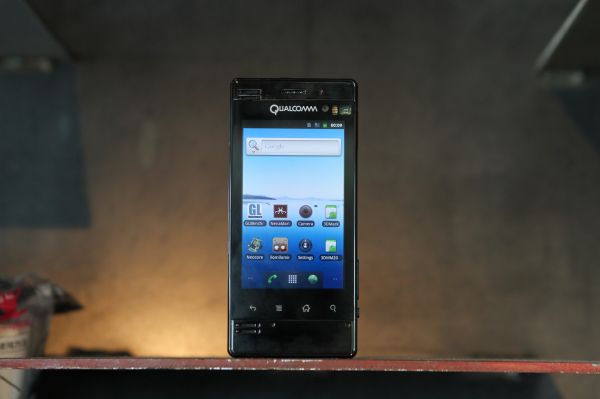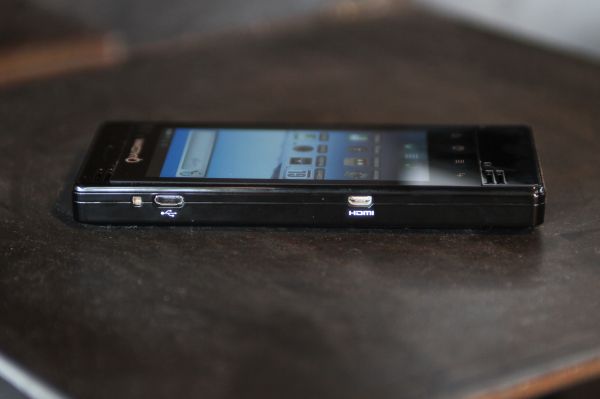Dual Core Snapdragon GPU Performance Explored - 1.5 GHz MSM8660 and Adreno 220 Benchmarks
by Brian Klug on March 30, 2011 4:29 PM EST- Posted in
- Smartphones
- Snapdragon
- Qualcomm
- Adreno
- MSM8660
- MDP
- Mobile
Way back at CES we saw our first glimpse of MSM8x60 and Qualcomm's Snapdragon Mobile Development Platform (MDP) with an MSM8660 SoC inside. Though we couldn't run any benchmarks on it, we got a sneak preview of dual core snapdragon. This year at MWC Qualcomm gave us a considerable amount of hands-on time with the same MDP hardware. We did a bit of testing, and then Qualcomm did something awesome - they let us take an MDP with the MSM8660 inside home with us.
In case you haven't been following, MSM8x60 is Qualcomm's first dual-core SoC. It's two Scorpion cores, an Adreno 220 GPU, and cellular modem all built on the 45 nm process. Like the rest of Qualcomm's lineup, the x in MSM8x60 can either be a 2, denoting GSM, UMTS, and HSPA+ support, or a 6, denoting all the same thing but with CDMA2000 and EVDO. Similarly, 9 will connote LTE support when we get to that point as well. MSM8x60 comes clocked at either 1.2 GHz or a higher 1.5 GHz. The MDP we were given was the higher 1.5 GHz variant. The MSM8x60 is the successor to MSM8x55, which is single core 1 GHz Snapdragon and Adreno 205, also built on 45 nm process.
| Qualcomm Mobile Development Platform (MDP) | |
| SoC | 1.5 GHz 45nm MSM8660 |
| CPU | Dual Core Snapdragon |
| GPU | Adreno 220 |
| RAM | (?) LPDDR2 |
| NAND | 8 GB integrated, microSD slot |
| Cameras | 13 MP Rear Facing with Autofocus and LED Flash, Front Facing (? MP) |
| Display | 3.8" WVGA LCD-TFT with Capacitive Touch |
| Battery | 3.3 Whr removable |
| OS | Android 2.3.2 (Gingerbread) |
It's been a bit busy since we got the MDP home with us, but we've run and re-run tests on the MDP all along and are ready to talk about GPU performance. The MDP we have right now is optimized for evaluating graphics performance, which we'll take a look at in this article. We'll then go into architectural changes between Adreno 200, 205, and 220, and then do the same combo of performance numbers plus architectural deep-dive with the CPU side of things in a future article.
The MDP itself is stark black and completely utilitiarian - it's a glossy, tall, extremely square package, but a smartphone nonetheless. It runs Android 2.3.2 (as an aside, isn't it ironic that prototype devices are running newer builds of Android than most smartphones you can buy retail right now) and has a number of interesting extras. There's a 13 MP rear facing camera with LED flash, front facing camera, 3.8" WVGA display, speakers, microHDMI port, microUSB, and microSD card slot. The MDP's battery is a comparatively tiny 3.3 Whr, but the entire package is totally mobile.
The one we have is again optimized for GPU testing, and sadly lacked cellular connectivity or WiFi, but gets the job done nonetheless.
The MDP's purpose is to act as a pre-commercial handset for software development rather than be something you'd ever carry around. Making reference hardware designed for developers isn't anything new in the SoC space - look no further than OMAP's Blaze platform. Qualcomm started making MDPs with the MSM8655 and sells them through bsquare, who sells them for $995. Though it isn't up yet, both these pages will soon have the MSM8660-based Mobile Development Platform.
One of the more interesting things about the MDP is that because it's a development platform, not a consumer device sold by an OEM though a carrier, it can either have Vsync enabled or disabled. This is the framerate cap we've seen on virtually every other device, which usually is right around 60 Hz. Through adb, we can turn Vsync on or off on the fly, then reboot Android's surface flinger and run tests. Sadly this procedure, while simple on the MDP, doesn't work on any other devices that aren't running Qualcomm's Android builds.
Since all of the devices we've tested thus far have been commercial, they've shipped with Vsync on and thus are limited to around 60 FPS. Thus, more than a few platforms could have had instantaneous bursts during test runs which are clipped to Vsync. To be fair to those, we've run everything on the MDP with Vsync on and off for illustrative purposes.
The MDP we tested was running all out, with maximum clocks and no power management thorottling CPU or GPU clocks down based on usage and load. As a result, testing was performed constantly plugged into a beefy USB AC power adapter. Though these benchmarks show off what MSM8660 is capable of, actual performance in shipping devices will obviously be different depending on UI, power management, and display resolution choices made by Qualcomm's OEM customers, like HTC.



















70 Comments
View All Comments
Griswold - Saturday, April 2, 2011 - link
Maybeso, but it will definitely run at a lower clockspeed.Blacula - Thursday, March 31, 2011 - link
The Samsung Galaxy Tab is in there too.djgandy - Thursday, March 31, 2011 - link
Looks like GLBenchmark is vsynced for the rest of the phones too.How exactly did you turn vsync off?
metafor - Thursday, March 31, 2011 - link
As mentioned in the article, it's a feature the development phone he used allowed but most phones don't.Chloiber - Thursday, March 31, 2011 - link
...when I look at 3DMark Mobile...my poor HTC Desire...Impressive performance! Looking forward to the HTC Pyramid ;)
duploxxx - Thursday, March 31, 2011 - link
uggh its very uglyalxxx - Thursday, March 31, 2011 - link
TI omap4460 is sampling according to TIhttp://focus.ti.com/general/docs/wtbu/wtbuproductc...
even though they haven't released the docs for omap4430
but can get them via pandaboard.org
see TRM http://pandaboard.org/content/resources/omap-devic...
omap5430 and 5432 look interesting
http://focus.ti.com/general/docs/wtbu/wtbuproductc...
Hey Brian or Anand how about getting a pandaboard and doing some benching.
You can load pandroid http://pandaboard.org/node/225/#android
http://omappedia.org/wiki/OMAP_Pandroid_Main
http://code.google.com/p/pandroid/
I'd volunteer mine but a bit to far away plus not familar with android, mostly run angstrom.
Other interesting one(for dsp people) is TI finally have their floating point dsps above 1Ghz
with the release of the new integra/sitra chips http://focus.ti.com/dsp/docs/dspcontent.tsp?conten...
FITCamaro - Thursday, March 31, 2011 - link
This is what I'm waiting for before I get a new phone. My Droid will be enough until then. I don't have 4G service in my area yet anyway.PWRuser - Thursday, March 31, 2011 - link
Hopefully the MDP has little RAM so that actual phones may perform better.It's early but in terms of performance, it appears that this SoC lines up somewhere between Tegra 2 and the (projected) Tegra 3 performance.
Also it will be interesting to see a refresh of this unit when the fab switches to 28nm.
SheldonCooper - Friday, April 1, 2011 - link
The Taiji test is pixel heavy since it is a closed environment whereas the Hoover test is texture heavy (lots of terrain). They are useful to compare unified shader vs dedicated pixel- and texture shader architecture.